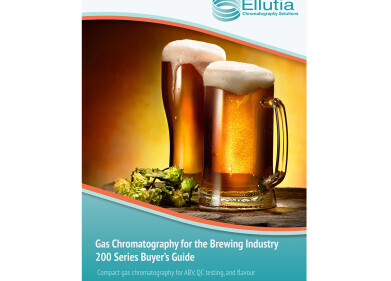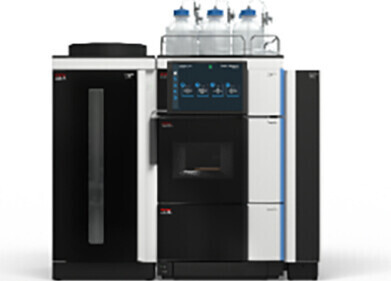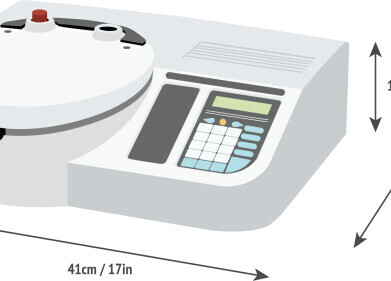-
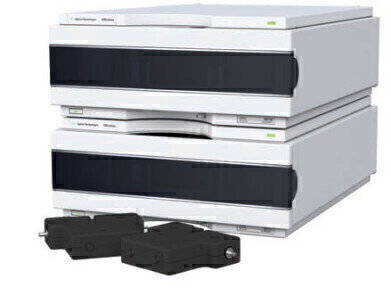
-
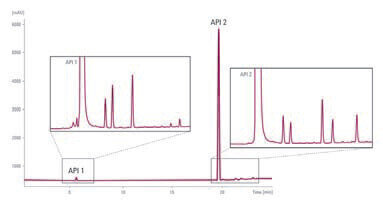 Figure 2. The concentrations of API 1 and API 2 are widely different and previously, two runs with different injection volumes would be necessary to quantify both main components and their respective impurities. With the Agilent High Dynamic Range DAD solution, customers can quantify all main components and all impurities in just one run, reducing the sample turnaround time and boosting their laboratory’s productivity.
Figure 2. The concentrations of API 1 and API 2 are widely different and previously, two runs with different injection volumes would be necessary to quantify both main components and their respective impurities. With the Agilent High Dynamic Range DAD solution, customers can quantify all main components and all impurities in just one run, reducing the sample turnaround time and boosting their laboratory’s productivity.
Chromatography
30x Wider Linear UV-Range – Quantification of Widely Different Concentrations in a Single Run
Apr 27 2012
The typical linear range of around 105 for UV-detection is not sufficient for the analysis of samples or compound mixtures with widely different concentration levels. Usually, these samples require additional sample preparation steps (dilution/concentration), in combination with a second injection and sometimes recalibration.
Now these time-consuming efforts can be eliminated by use of the Agilent 1200 Infinity Series High Dynamic Range Diode Array Detector (HDRDAD) solution. With 30-fold wider linear range, all sample information can be acquired in one single assay – increasing the productivity by reducing turnaround times.
30-fold wider linear UV-range
Expanding the linear dynamic range is achieved by making use of the technology in Agilent’s Max-Light flow cells. Optofluidic waveguides in these flow cells facilitate total internal reflection for superior light transmission. This gives extremely low detector noise regardless of the length of the optical path.
Two Agilent 1260 or 1290 Infinity diode array detectors are deployed; one is fitted with a 3.7mm path length flow cell, while the other has a longer 60mm path length flow cell. The signal from the longer path length cell is taken to quantify the low concentrations and the signal from the shorter path length cell is used for the high concentrations. Specially developed algorithms correct the different retention times and compute these signals to expand the linear dynamic range by a factor of 30 compared with earlier generation Agilent diode array detectors.
Up to 30-fold greater UV-sensitivity
The Agilent High Dynamic Range DAD solution extends the upper linearity level nearly three-fold – from 2 to typically 6 absorbance units – which allows to inject three-fold more sample and simultaneously benefit from 10-fold lower detector noise. This solution gives up to 30-fold greater sensitivity for simultaneous analysis and quantification of main compounds and impurities. Scientists gain more confidence in automated peak integration and achieve greater area precision for trace-level components.
Faster impurity analysis of fixed dose combinations
The Agilent HDR-DAD solution is the ideal tool for impurity analysis of fixed-dose combinations in which the active pharmaceutical ingredients (APIs) have very different concentrations. In a single assay, the active ingredients as well as impurities can be quantified, reducing significantly the sample turnaround time. Of course, any samples or formulations with largely different concentrations of there compounds are amenable to the HDR-DAD solution.
Increased productivity with the HDR-DAD solution
With the Agilent 1200 Infinity Series High Dynamic Range DAD solution, scientists can be sure that the sample concentration will fall within their calibration range, with no need for reanalysis, recalibration, or additional sample preparation steps. They will also benefit from greater instrument utilisation and lower solvent and waste costs.
Digital Edition
Lab Asia Dec 2025
December 2025
Chromatography Articles- Cutting-edge sample preparation tools help laboratories to stay ahead of the curveMass Spectrometry & Spectroscopy Articles- Unlocking the complexity of metabolomics: Pushi...
View all digital editions
Events
Jan 21 2026 Tokyo, Japan
Jan 28 2026 Tokyo, Japan
Jan 29 2026 New Delhi, India
Feb 07 2026 Boston, MA, USA
Asia Pharma Expo/Asia Lab Expo
Feb 12 2026 Dhaka, Bangladesh
